Abstract
Poly(propylene thiophenedicarboxylate) (PPTh) is a new type of fully biobased polyester with excellent thermal, mechanical, and barrier properties; however, its practical application has been seriously restricted by the relatively slow crystallization rate. To further improve the crystallization rate and broaden the potential application field of PPTh, PPTh/multi-walled carbon nanotubes (MWCNTs) composites were successfully synthesized via an in situ melt polycondensation process in this research. Low contents of MWCNTs were well dispersed in the PPTh matrix. MWCNTs significantly increased the melt crystallization temperature and isothermal crystallization rate of PPTh, indicating the effective heterogeneous nucleating agent role. PPTh/MWCNTs composites displayed the same crystal structure as PPTh. In addition, the introduction of MWCNTs significantly enhanced both the Young’s modulus and the tensile strength of PPTh. From a sustainable viewpoint, biobased PPTh/MWCNTs composites reported in this research were of significant importance and interest as they showed remarkably improved crystallization rates and mechanical properties.
1. Introduction
The over-reliance on fossil resources has caused serious environmental problems and irreversible ecological damage [1,2,3,4,5]. Biobased materials, as an emerging alternative resource, have significantly attracted academic and industrial concerns [6,7,8]. Currently, the study of biobased polyesters mainly focuses on aliphatic polyesters, such as poly(butylene succinate) (PBS), and polylactide (PLA); however, biobased aromatic polyesters have received relatively less attention [9].
Biobased aromatic polyesters contain a rigid structure of aromatic rings, which are superior to aliphatic polyesters in terms of thermal stability, mechanical strength, and barrier properties. Among them, 2,5-furandicarboxylic acid (FDCA) is a representative biobased aromatic monomer. As FDCA and terephthalic acid (TPA) display structural similarity, FDCA is regarded as an ideal substitute for TPA [10]. In addition, FDCA-based polyesters show superior physical properties, such as thermal, mechanical, and gas barrier properties [11,12,13].
2,5-thiophenedicarboxylic acid (TDCA) and FDCA also show similar molecular structures [14,15]. The only difference between these two monomers is the O atom on the five-membered aromatic ring for FDCA and the S atom for TDCA. The lower electronegativity of the S atom endorses the thiophene ring with a higher resonance energy and a lower dipole moment. Therefore, the aromaticity of the thiophene ring is closer to that of the benzene ring than that of the furan ring [16]. Currently, TDCA-based polyesters have also extensively been studied [17,18,19,20,21]. For instance, Lotti et al. once synthesized high molecular weight poly(butylene 2,5-thiophenedicarboxylate) (PBTh) via a two-step melt polycondensation reaction, which showed a semicrystalline nature, and good thermal, mechanical, and gas barrier properties [22]. Furthermore, we recently reported the isothermal crystallization kinetics and melting behavior of PBTh, which displayed the fastest crystallization rate at 104 °C and double-melting behavior between 100 and 120 °C [23]. Wang et al. recently synthesized some TDCA-based polyesters, such as poly(ethylene thiophenedicarboxylate) (PETh), poly(propylene thiophenedicarboxylate) (PPTh), PBTh, and poly(hexamethylene thiophenedicarboxylate) (PHTh) [21].
Among TDCA-based polyesters, PPTh possesses excellent mechanical and thermal properties [21]. Lotti et al. reported the thermal properties of PPTh in 2018 [16]. They found that the glass transition temperature, melting point, and thermal decomposition temperature of PPTh were 38, 183, and 373 °C, respectively. The Young’s modulus and tensile strength were 1419 ± 165 and 12 ± 4 MPa, respectively. PPTh exhibited excellent gas barrier properties, with gas transport rates of 0.0202 ± 14 × 10−5 and 0.0243 ± 13 × 10−5 cm3/(m2·day·bar) for O2 and CO2 at 23 °C, respectively.
In order to further expand the application, a few studies have been conducted on the use of copolymerization modification to adjust the thermal and mechanical properties of PPTh [24,25,26,27,28]. For example, Tian et al. found that poly(propylene succinate-co-thiophenedicarboxylate) copolyester showed excellent gas barrier and degradation properties [24]. Wang et al. introduced 1,6-adipic acid as the third comonomer and synthesized poly(propylene adipate-co-thiophenedicarboxylate) (PPATh) copolyesters with enhanced degradation ability and elongation at break [28]. The elongation at break of PPATh60 (propylene thiophenedicarboxylate unit = 60 mol%) even reached 560 ± 15% [28]. It should be noted that the crystallization rate and mechanical property of PPTh should be further enhanced from a viewpoint of practical application.
In the literature, one of the most efficient methods to significantly improve the crystallization rate and mechanical properties, especially the Young’s modulus as well as the tensile strength of the polymer matrix, is the preparation of polymer composites [29,30,31,32]. For instance, Klonos et al. synthesized several poly(propylene 2,5-furandicarboxylate) (PPF)-based composites. The introduction of montmorillonite, carbon nanotubes, and graphene improved both the mechanical strength and the crystallization rate of PPF [33,34]. Multi-walled carbon nanotubes (MWCNTs) have extensively been used as nanofillers in polymer composites [35,36,37,38,39,40,41,42,43,44,45,46,47,48,49,50]. They can reinforce polymer matrices [35,36,37,38]. Many polymer/MWCNTs composites have already been studied in the literature [39,40,41,42,43,44,45]. On the one hand, as a kind of reinforcing filler, MWCNTs significantly enhance the mechanical properties of polymer matrices [39,40]. On the other hand, by virtue of their efficient heterogeneous nucleation agent role, MWCNTs also effectively increase the crystallization rate of polymers [41,42]. In addition, MWCNTs can also be used in antistatic coatings [46,47]. Similarly, we have also prepared and reported the properties of some polyester/MWCNTs composites in previous studies, such as poly(hexamethylene 2,5-furandicarboxylate) (PHF) and poly(neopentyl glycol 2,5-furandicarboxylate) (PNF) [48,49,50].
Novel biobased PPTh/MWCNTs composites were prepared via an in situ synthesis polymerization method with 0.1 and 0.2 wt% of MWCNTs in this research; moreover, the effect of low loadings of MWCNTs on the crystallization behavior and mechanical properties of PPTh were investigated in detail. The novelties of this research are summarized as follows. First, novel biobased PPTh/MWCNTs composites were prepared for the first time. Second, low loadings of MWCNTs significantly increased both the crystallization rate and the Young’s modulus and tensile strength of PPTh, which should be important from an application viewpoint. Third, biobased PPTh/MWCNTs composites may find potential end use as promising packaging materials. The results should be of great importance and help in biobased polymer composites and polymer crystallization.
2. Experimental Section
2.1. Materials
TDCA (purity 99%) was supplied by Zhengzhou Alpha Chemical Co., Ltd., Zhengzhou, China. 1,3-propanediol (PDO, purity 99%) was bought from Shanghai McLean Biochemical Technology Co., Shanghai, China. MWCNTs was purchased from Chengdu Institute of Organic Chemistry, Chinese Academy of Sciences, China. Catalyst tetrabutyl titanate (TBT) was obtained from Beijing Changping Jingxiang Chemical Reagent Factory, Beijing, China.
2.2. Synthesis of PPTh and PPTh/MWCNTs Composites
PPTh/MWCNTs composites were synthesized via an in situ melt polycondensation method using TDCA, PDO (TDCA:PDO was 1:2 in molar ratio), and MWCNTs as raw materials, and the MWCNTs loadings were 0.1 and 0.2 wt%, respectively. The synthetic route is shown in Scheme 1. Firstly, PDO and MWCNTs were introduced into a 100 mL of three-neck flask. The mixture was sonicated for 60 min to obtain homogeneous dispersion of MWCNTs in PDO. Afterwards, TDCA was introduced into the flask; moreover, the reactants reacted at 180–190 °C under nitrogen for 3–4 h until no water was distilled out. During the polycondensation stage, the pressure was gradually reduced to below 200 Pa over a period of 1 h and the temperature was slowly increased to 220–230 °C for 4–5 h. When the Weissenberg effect occurred, the reaction ended. PPTh was also synthesized using the same procedure.
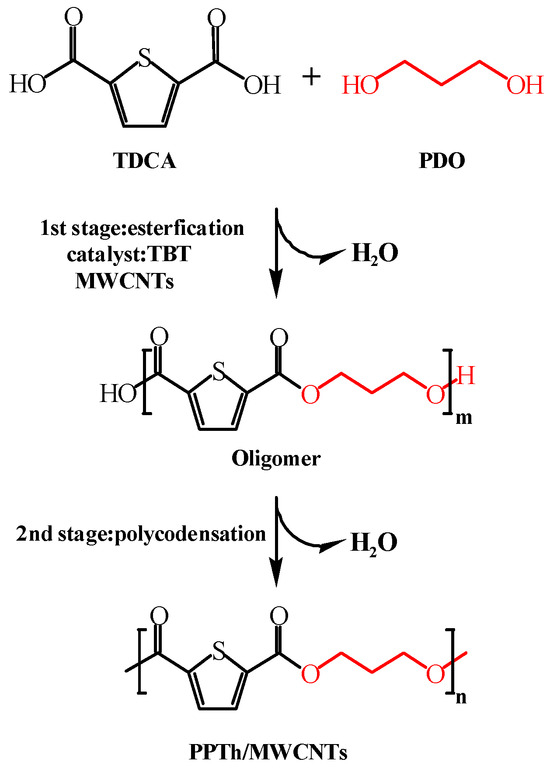
Scheme 1.
Synthesis route of PPTh and PPTh/MWCNT composites.
2.3. Characterizations
Hydrogen nuclear magnetic resonance (1H NMR) was determined on a Bruker AV 600 MHz instrument using CF3COOD as the deuterated solvent.
The intrinsic viscosity [η] was determined via a one-point method at 25 °C in a phenol/1,1,2,2-tetrachloroethane (w/w = 1:1) mixture at a concentration of 0.4 g/dL using a Ubbelohde viscometer. [η] was obtained through the following Solomone–Ciuta equation [51]:
where t and t0 are the flow time of the solution and that of the pure solvent, respectively, while c is the concentration of the solution.
Scanning electron microscopy (SEM) (JEOL JSM-7800F) was used to observe the newly fractured surfaces of PPTh and its composites after they were first coated with gold before observation.
The thermal stability was analyzed by thermogravimetric analysis (TGA) using a TA Q50 instrument (New Castle, DE, USA). The samples (about 7–10 mg) were heated at a heating rate of 20 °C/min from 50 to 580 °C under N2 with a flow rate of 50 mL/min.
A TA Q100 differential scanning calorimeter (DSC) was used to study the crystallization behavior of PPTh and PPTh/MWCNTs composites. The samples were first annealed at 210 °C for 3 min to eliminate thermal history. For studying the basic thermal parameters, the samples were cooled to 0 °C at 60 °C/min and then heated to 210 °C at 10 °C/min. The non-isothermal melt crystallization behavior was studied at a cooling rate of 10 °C/min. For the isothermal melt crystallization kinetics study, the samples were quenched to a selected crystallization temperature (148–160 °C) at 60 °C/min and held for a certain period of time to ensure complete crystallization.
The crystal structure was studied with a Rigaku Ultima IV X-ray diffractometer in the 2θ range of 5°–55° at 5°/min. All samples crystallized first for 12 h in an oven at 100 °C before the measurement.
The tensile test was performed on a UTM5205XHD tensile instrument (SUNS, Zhangzhou, China). Dumb-bell shaped samples (50 mm × 5 mm × 1 mm) were prepared by a hot compression molding method. All specimens were measured at a cross speed of 20 mm/min.
3. Results and Discussion
3.1. Chemical Structure and [η] Value Studies
The chemical structures of PPTh and its composites were characterized by 1H NMR. As shown in Figure 1, the characteristic peaks were assigned as follows. The signals at 7.78 and 4.56 ppm corresponded to the thiophene ring proton (a) and the PDO methylene proton adjacent to the ester bond (b), respectively, while the peak at 2.30 ppm was from the proton in the PDO chain segment (c). Notably, no additional chemical shift signals were observed in the spectra of the composites, suggesting that MWCNTs did not change the chemical structure of PPTh.
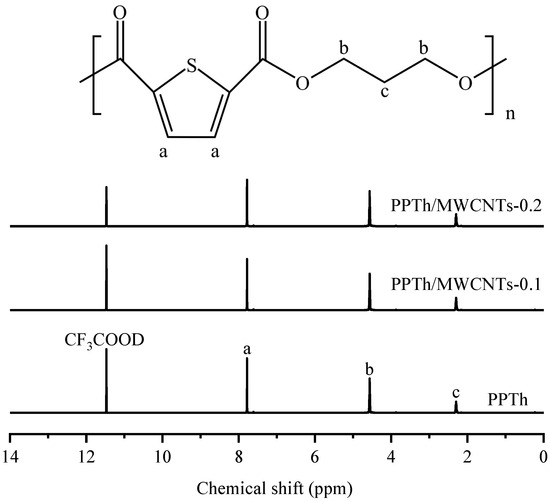
Figure 1.
Chemical structures and 1H NMR spectra of PPTh and PPTh/MWCNTs composites.
PPTh and PPTh/MWCNTs composites were insoluble in tetrahydrofuran; therefore, intrinsic viscosity was used as a substitute for the molecular weight characterization in this study. The [η] values were measured to be 0.91, 0.85, and 0.87 dL/g for PPTh, PPTh/MWCNTs-0.1, and PPTh/MWCNTs-0.2, respectively. All the three samples showed high and similar [η] values. Both the 1H NMR and the high and similar [η] values indicated the successful synthesis of PPTh and its composites.
3.2. Dispersion of MWCNTs in PPTh Matrix
The dispersion of MWCNTs in the PPTh matrix was first observed with SEM. Figure 2 illustrates the SEM images of PPTh, PPTh/MWCNTs-0.1, and PPTh/MWCNTs-0.2. In Figure 2a, only white lines formed by stress whitening were observed, while in parts b and c of Figure 2, white rod-like spots of MWCNTs were randomly dispersed in the PPTh matrix. No obvious aggregation of MWCNTs was observed in the PPTh matrix, indicating that low loadings of MWCNTs achieved a uniform dispersion. Such a result should be greatly important for the improved physical properties of PPTh in later sections.
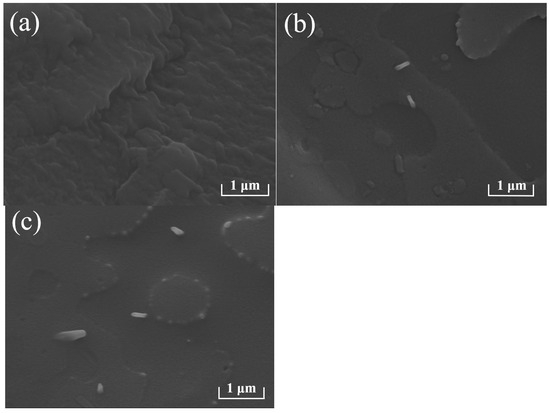
Figure 2.
SEM images for (a) PPTh, (b) PPTh/MWCNTs-0.1, and (c) PPTh/MWCNTs-0.2.
3.3. Thermal Stability and Basic Thermal Properties Studies
The TGA curves of PPTh and PPTh/MWCNTs composites are shown in Figure 3. All samples showed similar TGA curves and one-step thermal degradation behavior. The degradation temperature at 5 wt% weight loss (Td) of PPTh was 379.2 °C while those of PPTh/MWCNTs-0.1 and PPTh/MWCNTs-0.2 were 378.7 and 379.8 °C, respectively. The values of Td were all close to 380 °C, indicating that PPTh and PPTh/MWCNTs possessed superior thermal stability; moreover, low loadings of MWCNTs showed no apparent effect on the thermal stability of PPTh.
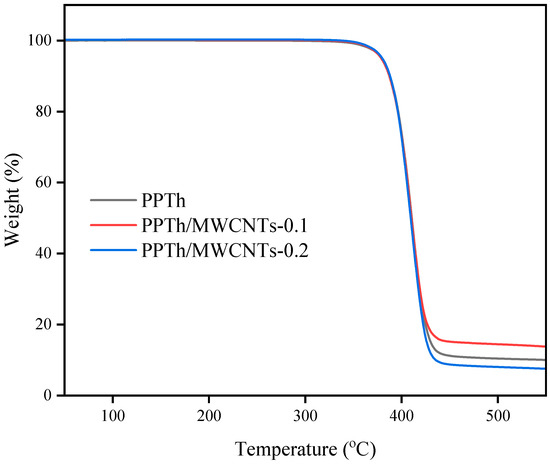
Figure 3.
TGA curves for PPTh and PPTh/MWCNTs composites.
The influence of MWCNTs on the basic thermal parameters of PPTh was further studied. Figure 4 displays the DSC heating traces of PPTh and its composites at 10 °C/min, which were first cooled from the molten state at a fast cooling rate of 60 °C/min. As seen in Figure 4, the glass transition temperature (Tg) values of PPTh, PPTh/MWCNTs-0.1, and PPTh/MWCNTs-0.2 were 36.8, 37.3, and 37.9 °C, respectively. The Tg values slightly moved to higher temperatures in polymer composites because the introduction of low loadings of MWCNTs reduced the motility of the molecular chains to some degree. The cold crystallization temperature (Tch), cold crystallization enthalpy (ΔHch), melting temperature (Tm), and melting enthalpy (ΔHm) of PPTh were 92.1 °C, 36.6 J/g, 185.4 °C, and 45.1 J/g, respectively; however, the introduction of low loadings of MWCNTs slightly influenced the Tch and Tm values of PPTh in the composites. The relevant data are listed in Table 1.
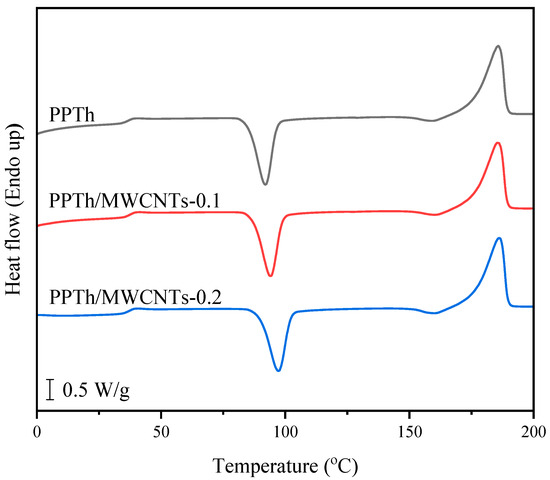
Figure 4.
DSC heating curves of PPTh and PPTh/MWCNTs composites at 10 °C/min after cooling at 60 °C/min.

Table 1.
The [η] values and thermal properties data of PPTh and PPTh/MWCNTs composites.
3.4. Crystallization Behavior Study
Figure 5 demonstrates the melt crystallization behavior of PPTh and its composites at 10 °C/min. The melt crystallization temperature (Tcc) of the composites significantly increased after the introduction of MWCNTs. For instance, Tcc increased from 98.2 °C for PPTh to 120.1 °C for PPTh/MWCNTs-0.1 and 126.7 °C for PPTh/MWCNTs-0.2, respectively. Meanwhile, the corresponding melt crystallization enthalpy (ΔHcc) also showed an increase from 19.8 J/g for PPTh to 26.3 J/g for PPTh/MWCNTs-0.1 and 31.9 J/g for PPTh/MWCNTs-0.2, respectively. The above increase in both Tcc and ΔHcc confirmed that MWCNTs effectively enhanced the non-isothermal melt crystallization of PPTh, suggesting the effective heterogeneous nucleating agent role of MWCNTs in the composites.
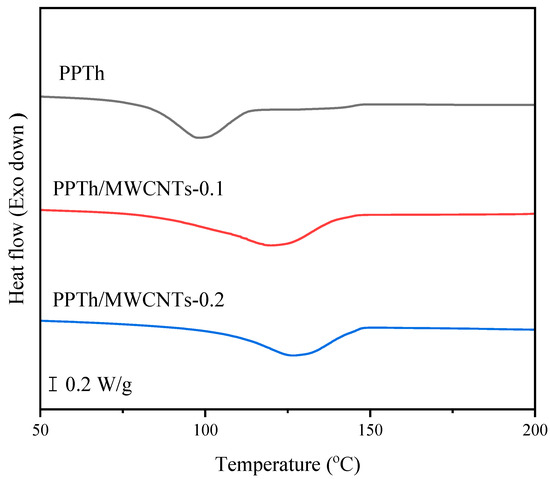
Figure 5.
Melt crystallization behavior at 10 °C/min for PPTh and PPTh/MWCNTs composites.
The isothermal crystallization kinetics study was performed with DSC in this section for PPTh and the two composites. Figure 6 illustrates the plots of relative crystallinity (Xt) versus crystallization time (t) for PPTh and PPTh/MWCNTs composites at the specified crystallization temperature (Tc). As Tc increased, crystallization time of each sample gradually prolonged, suggesting a slower crystallization rate at higher Tc, while at the same Tc, the increase in MWCNTs loading significantly shortened the crystallization time, indicating a faster crystallization rate.
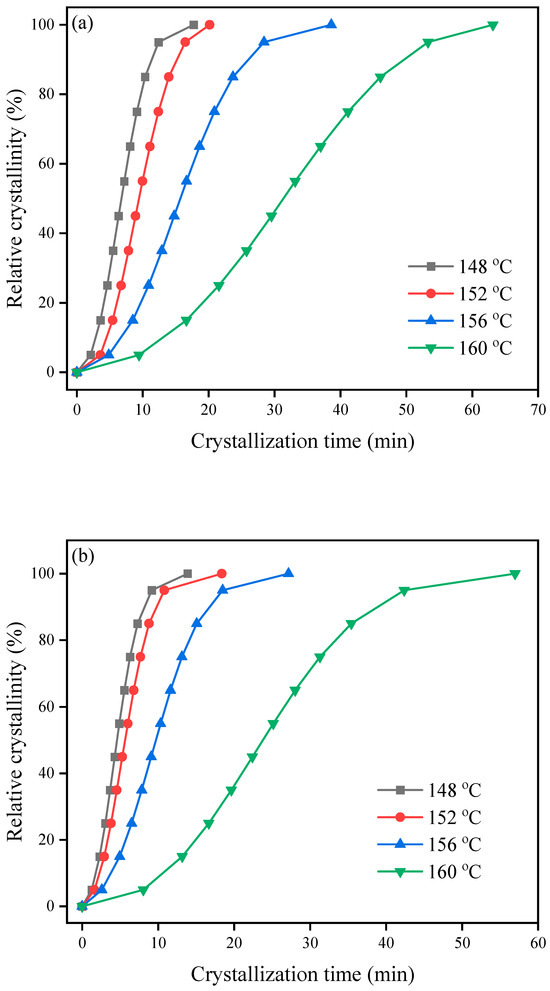
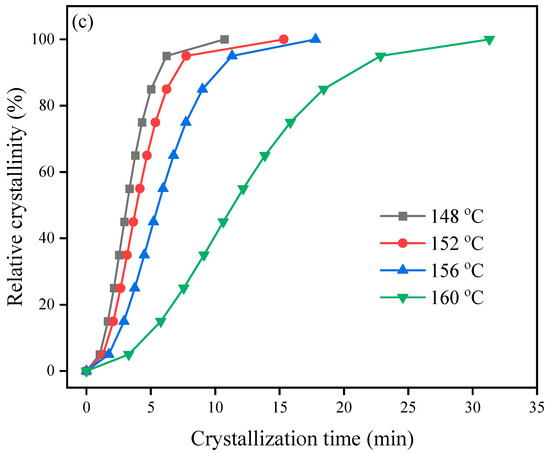
Figure 6.
Plots of relative crystallinity versus crystallization time for (a) PPTh, (b) PPTh/MWCNTs-0.1, and (c) PPTh/MWCNTs-0.2.
The Avrami equation was further used to study the isothermal crystallization kinetics of PPTh and PPTh/MWCNTs composites as follows:
where Xt is the relative crystallinity, k is the crystallization rate constant, and n is the Avrami index [52,53].
Figure 7 shows the Avrami plots of PPTh and PPTh/MWCNTs composites, from which a series of almost parallel fitting curves were acquired. Such results indicated that the Avrami equation reasonably described the isothermal melt crystallization kinetics of both PPTh and PPTh/MWCNTs composites. The n values of PPTh and PPTh/MWCNTs composites varied slightly between 2.1 and 2.6, suggesting the same crystallization mechanism. It is interesting to discuss the nature of crystalline formation. According to the Avrami index, it is probably the growth of rod-shaped formations from sporadic nuclei, and the fractional value indicates heterogeneous heterogeneity of the crystal, impurities, inclusions [54]. However, further morphological study is necessary to support this crystallization mechanism. Moreover, the k values of PPTh/MWCNTs were greater than that of PPTh at the same Tc. The obtained data are shown in Table 2.
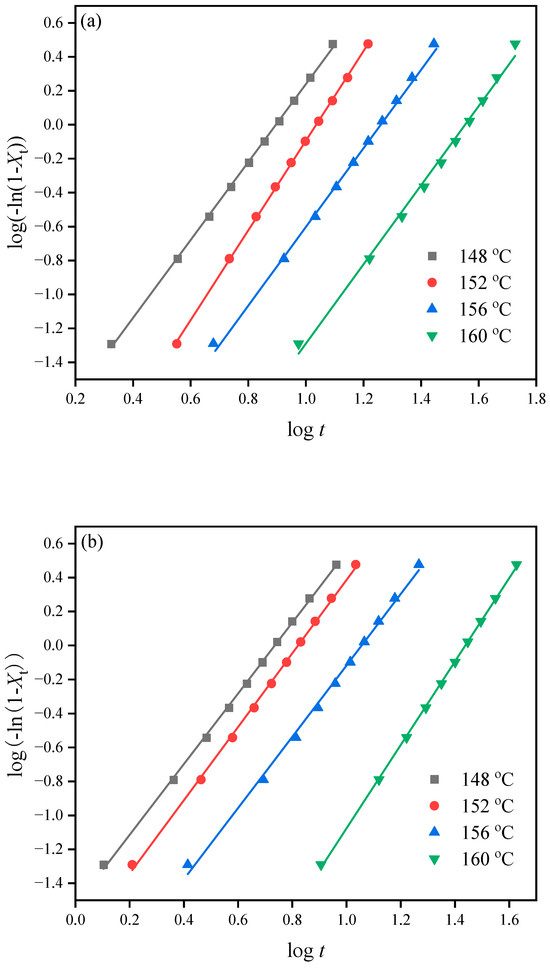
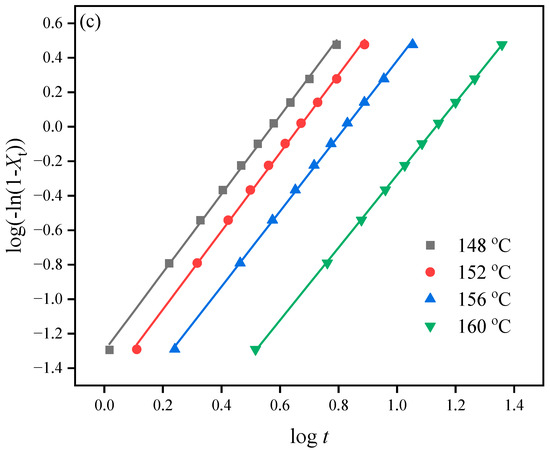
Figure 7.
Avrami plots for (a) PPTh, (b) PPTh/MWCNTs-0.1, and (c) PPTh/MWCNTs-0.2.

Table 2.
Related Avrami parameters for PPTh and PPTh/MWCNTs composites.
Crystallization half-time (t0.5) is a key parameter for evaluating the crystallization rate in polymer crystallization, which was calculated by the following equation:
Figure 8 displays the plots of t0.5 versus Tc for PPTh and its composites. With the decrease of Tc, the t0.5 value of each sample significantly decreased, indicating an accelerated crystallization rate. Furthermore, MWCNTs significantly reduced the t0.5 value of PPTh in the composites. For example, the t0.5 value of PPTh was 30.52 min at 160 °C, while that of PPTh/MWCNTs-0.2 was only 15.87 min. In brief, low loadings of MWCNTs significantly promoted the isothermal crystallization rate of PPTh by acting as an effective nucleation agent. Similar results also were reported in some polyester/MWCNTs composites [48,49,50].
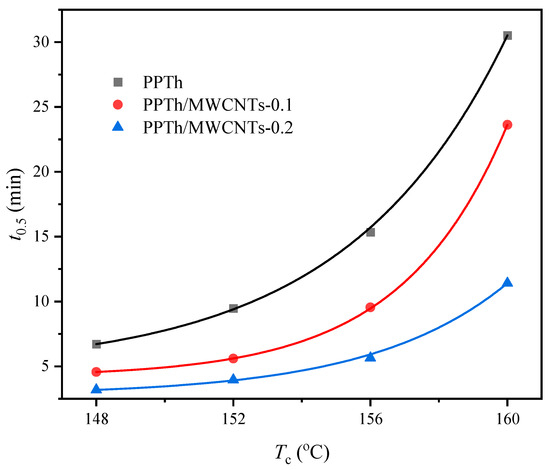
Figure 8.
Plots of t0.5 versus Tc for PPTh and PPTh/MWCNTs composites.
Figure 9 illustrates the wide-angle X-ray diffraction (WAXD) patterns of all samples after they finished crystallization for 12 h at 100 °C. They presented three main diffraction peaks at 2θ = 16.5°, 23.5°, and 25.8°, indicating that the composites and PPTh exhibited the same crystal structure. In addition, the crystallinity values were determined to be 23 ± 2% for all the three samples on the basis of Figure 9. In sum, the incorporation of low loadings of MWCNTs did not modify the crystal structure and showed no apparent effect on the crystallinity of PPTh.
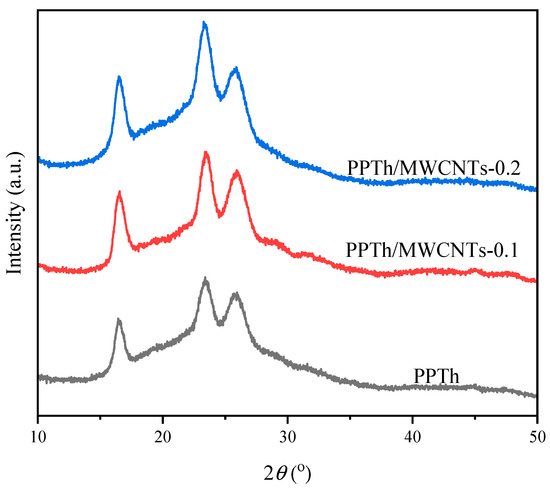
Figure 9.
WAXD profiles for PPTh and PPTh/MWCNTs composites.
3.5. Mechanical Property Study
Figure 10 depicts the typical stress–strain curves of PPTh and PPTh/MWCNTs composites, exhibiting significant yielding behavior. The incorporation of low loadings of MWCNTs remarkably increased the Young’s modulus (E) and tensile strength (σb) values of PPTh. For example, the E value increased from 1122.5 ± 35.1 MPa for PPTh to 1412.1 ± 8.1 MPa for PPTh/MWCNTs-0.2, an increase of about 27%, while the Yield strength (σy) also increased from 26.1 ± 0.6 MPa for PPTh to 46.6 ± 3.2 MPa for PPTh/MWCNTs-0.2, an increase of about 77%. However, a slight decrease in the elongation at break (εb) was observed because MWCNTs may act as both the defect and the stress concentration during the tensile deformation process. Although the introduction of MWCNTs led to a reduction in εb to some extent, the composites still maintained excellent and balanced mechanical properties. The related data are listed in Table 3.
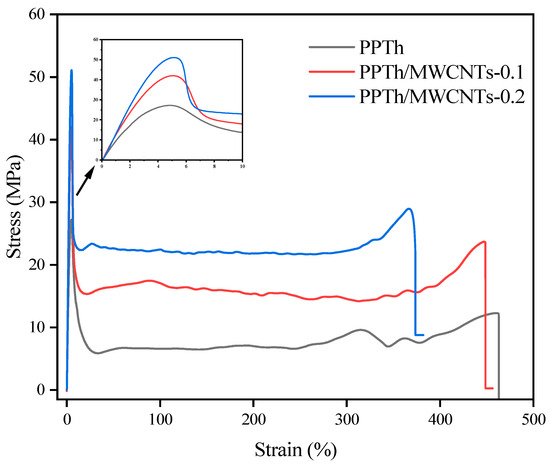
Figure 10.
Stress–strain curves for PPTh and PPTh/MWCNTs composites.

Table 3.
Mechanical property data of PPTh and PPTh/MWCNTs composites.
4. Conclusions
Novel biobased PPTh/MWCNTs composites were successfully prepared by an in situ melt polycondensation method in this work. The successful synthesis of the composites was confirmed by 1H NMR. SEM results indicated an even dispersion of MWCNTs in the PPTh matrix. PPTh/MWCNTs composites still maintained good thermal stability. In the presence of only 0.2 wt% of MWCNTs, the melt crystallization temperature of PPTh increased from 98.2 to 126.7 °C at 10 °C/min, while the crystallization half-time decreased from 30.52 to 15.87 min at 160 °C. However, the introduction of MWCNTs did not change the crystal structure of PPTh. Furthermore, the introduction of MWCNTs significantly increased the E and σy values of PPTh. The E value of PPTh/MWCNTs-0.2 increased from 1122.5 ± 35.1 to 1412.1 ± 8.1 MPa while the σy value increased from 26.1 ± 0.6 to 46.6 ± 3.2 MPa. In brief, MWCNTs remarkably improved both the crystallization rate and the mechanical property of PPTh at low loadings, which should be greatly helpful for the application of PPTh.
Author Contributions
Investigation, C.Z.; writing—original draft preparation, C.Z.; writing—review and editing, S.F. and Z.Q.; supervision, Z.Q.; funding acquisition, Z.Q. All authors have read and agreed to the published version of the manuscript.
Funding
This research was funded by the National Natural Science Foundation of China (52173019 amd 52473092).
Data Availability Statement
The data presented in this study are available on request from the corresponding author.
Acknowledgments
The authors are grateful to the National Natural Science Foundation of China (52173019 and 52473092).
Conflicts of Interest
The authors declare no conflict of interest.
References
- Jain, R.; Tiwari, A. Biosynthesis of planet friendly bioplastics using renewable carbon source. J. Environ. Health Sci. 2015, 13, 11. [Google Scholar] [CrossRef]
- Park, J.; Koo, M.; Cho, S.; Lyu, M. Comparison of thermal and optical properties and flowability of fossil-based and bio-based polycarbonate. Macromol. Res. 2017, 25, 1135–1144. [Google Scholar] [CrossRef]
- Borrelle, S.; Ringma, J.; Law, K.; Monnahan, C.; Lebreton, L.; McGivern, A.; Murphy, E.; Jambeck, J.; Leonard, G.; Hilleary, M.; et al. Predicted growth in plastic waste exceeds efforts to mitigate plastic pollution. Science 2020, 369, 1515–1518. [Google Scholar] [CrossRef]
- Kane, I.; Clare, M.; Miramontes, E.; Wogelius, R.; Rothwell, J.; Garreau, P.; Pohl, F. Seafloor microplastic hotspots controlled by deep-sea circulation. Science 2020, 368, 1140–1145. [Google Scholar] [CrossRef] [PubMed]
- Li, Y.; Li, S.; Sun, J. Degradable poly(vinyl alcohol)-based supramolecular plastics with high mechanical strength in a watery environment. Adv. Mater. 2021, 33, 2007371. [Google Scholar] [CrossRef] [PubMed]
- Cywar, R.; Rorrer, N.; Hoyt, C.; Beckham, G.; Chen, E. Bio-based polymers with performance-advantaged properties. Nat. Rev. Mater. 2022, 7, 83–103. [Google Scholar] [CrossRef]
- Rai, P.; Mehrotra, S.; Priya, S.; Gnansounou, E.; Sharma, S. Recent advances in the sustainable design and applications of biodegradable polymers. Bioresour. Technol. 2021, 325, 124739. [Google Scholar] [CrossRef] [PubMed]
- Zhang, Q.; Song, M.; Xu, Y.; Wang, W.; Wang, Z.; Zhang, L. Bio-based polyesters: Recent progress and future prospects. Prog. Polym. Sci. 2021, 120, 101430. [Google Scholar] [CrossRef]
- Vilela, C.; Sousa, A.; Fonseca, A.; Serra, A.; Coelho, J.; Freire, C.; Silvestre, A. The quest for sustainable polyesters—Insights into the future. Polym. Chem. 2014, 5, 3119–3141. [Google Scholar] [CrossRef]
- Bozell, J.; Petersen, G. Technology development for the production of biobased products from biorefinery carbohydrates-the US Department of Energy’s “Top 10” revisited. Green Chem. 2010, 12, 539–554. [Google Scholar] [CrossRef]
- Fei, X.; Wang, J.; Zhang, X.; Jia, Z.; Jiang, Y.; Liu, X. Recent progress on bio-based polyesters derived from 2,5-furandicarbonxylic acid (FDCA). Polymers 2022, 14, 625. [Google Scholar] [CrossRef] [PubMed]
- Papageorgiou, G.; Papageorgiou, D.; Terzopoulou, Z.; Bikiaris, D. Production of bio-based 2,5-furan dicarboxylate polyesters: Recent progress and critical aspects in their synthesis and thermal properties. Eur. Polym. J. 2016, 83, 202–229. [Google Scholar] [CrossRef]
- Zhang, J.; Li, J.; Tang, Y.; Lin, L.; Long, M. Advances in catalytic production of bio-based polyester monomer 2,5-furandicarboxylic acid derived from lignocellulosic biomass. Carbohydr. Polym. 2015, 130, 420–428. [Google Scholar] [CrossRef]
- Polen, T.; Spelberg, M.; Bott, M. Toward biotechnological production of adipic acid and precursors from biorenewables. J. Biotechnol. 2013, 167, 75–84. [Google Scholar] [CrossRef]
- Zhi, W.; Hu, Y.; Liang, M.; Liu, Y.; Li, J.; Yin, J.; Shi, Y. Solid-liquid equilibrium and thermodynamic of 2,5-thiophenedicarboxylic acid in different organic solvents. Fluid Phase Equilib. 2014, 375, 110–114. [Google Scholar] [CrossRef]
- Guidotti, G.; Soccio, M.; Lotti, N.; Gazzano, M.; Siracusa, V.; Munari, A. Poly(propylene 2,5-thiophenedicarboxylate) vs. Poly(propylene 2,5-furandicarboxylate): Two examples of high gas barrier bio-based polyesters. Polymers 2018, 10, 785. [Google Scholar] [CrossRef]
- Bertolini, F.; Soccio, M.; Weinberger, S.; Guidotti, G.; Gazzano, M.; Guebitz, G.; Lotti, N.; Pellis, A. Unveiling the enzymatic degradation process of biobased thiophene polyesters. Front. Chem. 2021, 9, 771612. [Google Scholar] [CrossRef]
- Djouonkep, L.; Cheng, Z.; Siegu, K.; Jing, X.; Chen, J.; Adom, E.; Muaz, A.; Gauthier, M. High performance sulfur-containing copolyesters from bio-sourced aromatic monomers. eXPRESS Polym. Lett. 2022, 16, 102–114. [Google Scholar] [CrossRef]
- Guidotti, G.; Soccio, M.; Gazzano, M.; Siracusa, V.; Lotti, N. Poly(alkylene 2,5-thiophenedicarboxylate) polyesters: A new class of bio-based high-performance polymers for sustainable packaging. Polymers 2021, 13, 2460. [Google Scholar] [CrossRef]
- Wang, G.; Liang, Y.; Jiang, M.; Zhang, Q.; Wang, R.; Wang, H.; Zhou, Y. Synthesis and characterization of bio-based polyesters from 2,5-thiophenedicarboxylic acid. Polym. Degrad. Stab. 2019, 168, 108942. [Google Scholar] [CrossRef]
- Wang, J.; Zhang, X.; Shen, A.; Zhu, J.; Song, P.; Wang, H.; Liu, X. Synthesis and properties investigation of thiophene-aromatic polyesters: Potential alternatives for the 2,5-furandicarboxylic acid-based ones. Chin. J. Polym. Sci. 2020, 38, 1082–1091. [Google Scholar] [CrossRef]
- Guidotti, G.; Gigli, M.; Soccio, M.; Lotti, N.; Gazzano, M.; Siracusa, V.; Munari, A. Poly(butylene 2,5-thiophenedicarboxylate): An added value to the class of high gas barrier biopolyesters. Polymers 2018, 10, 167. [Google Scholar] [CrossRef] [PubMed]
- Chen, C.; Pan, S.; Qiu, Z. Crystallization kinetics and melting behavior of novel biobased poly(butylene 2,5-thiophenedicarboxylate). Chemistryselect 2024, 9, e202401725. [Google Scholar] [CrossRef]
- Tian, S.; Shi, K.; Xu, J.; Guo, B. Synthesis and structure-property relationships of novel high molecular weight fully biobased 2,5-thiophenedicarboxylic acid-based polyesters. Biomacromolecules 2023, 24, 2998–3008. [Google Scholar] [CrossRef] [PubMed]
- Wang, G.; Dong, Y. Bio-based poly(propylene 2,5-furandicarboxylate -co-propylene 2,5-thiophenedicarboxylate): Synthesis and characterization. Polym. Bull. 2024, 81, 4609–4627. [Google Scholar] [CrossRef]
- Wang, G.; Jiang, M.; Zhang, Q.; Wang, R.; Liang, Q.; Zhou, G. New bio-based copolyesters poly(trimethylene 2,5-thiophenedicarboxylate-co-trimethylene terephthalate): Synthesis, crystallization behavior, thermal and mechanical properties. Polymer 2019, 173, 27–33. [Google Scholar] [CrossRef]
- Wang, G.; Yang, G.; Jiang, M.; Wang, R.; Liang, Y.; Zhou, G. Poly(propylene naphthalate-co-propylene 2,5-thiophenedicarboxylate)s derived from bio-based 2,5-thiophenedicarboxylic acid (TDCA): Synthesis and properties. Polym. Test. 2021, 93, 106955. [Google Scholar] [CrossRef]
- Wang, Q.; Li, J.; Dong, Y.; Hu, H.; Oyoung, D.; Hu, D.; Zhang, Y.; Wei, D.; Wang, J.; Zhu, J. Biodegradable copolyesters derived from 2,5-thiophenedicarboxylic acid for high gas barrier packaging applications: Synthesis, crystallization properties, and biodegradation mechanisms. ACS Sustain. Chem. Eng. 2024, 12, 12086–12100. [Google Scholar] [CrossRef]
- Kourtidou, D.; Klonos, P.; Papadopoulos, L.; Kyritsis, A.; Bikiaris, D.; Chrissafis, K. Molecular mobility and crystallization of renewable poly(ethylene furanoate) filled with carbon nanotubes and graphene nanoparticles. Soft Matter 2021, 17, 5815–5828. [Google Scholar] [CrossRef]
- Papadopoulos, L.; Terzopoulou, Z.; Bikiaris, D.; Patsiaoura, D.; Chrissafis, K.; Papageorgiou, D.; Papageorgiou, G. Synthesis and characterization of in-situ-prepared nanocomposites based on poly(propylene 2,5-furan dicarboxylate) and aluminosilicate clays. Polymers 2018, 10, 937. [Google Scholar] [CrossRef]
- Sanusi, O.; Papadopoulos, L.; Klonos, P.; Terzopoulou, Z.; Hocine, N.; Benelfellah, A.; Papageorgiou, G.; Kyritsis, A.; Bikiaris, D. Calorimetric and dielectric study of renewable poly(hexylene 2,5-furan-dicarboxylate)-based nanocomposites on situ filled with small amounts of graphene platelets and silica nanoparticles. Polymers 2020, 12, 1239. [Google Scholar] [CrossRef]
- Xie, H.; Meng, H.; Wu, L.; Li, B.; Dubois, P. In-situ synthesis, thermal and mechanical properties of biobased poly (ethylene 2,5-furandicarboxylate) /montmorillonite (PEF/MMT) nanocomposites. Eur. Polym. J. 2019, 121, 109266. [Google Scholar] [CrossRef]
- Klonos, P.; Papadopoulos, L.; Papageorgiou, G.; Kyritsis, A.; Pissis, P.; Bikiaris, D. Interfacial interactions, crystallization, and molecular dynamics of renewable poly(propylene furanoate) filled with initial and surface functionalized carbon nanotubes and graphene oxide. J. Phys. Chem. C 2020, 124, 10220–10234. [Google Scholar] [CrossRef]
- Klonos, P.; Papadopoulos, L.; Tzetzis, D.; Kyritsis, A.; Papageorgiou, G.; Bikiaris, D. Thermal, nanoindentation and dielectric study of nanocomposites based on poly(propylene furanoate) and various inclusions. Mater. Today Commun. 2019, 20, 100585. [Google Scholar] [CrossRef]
- Xu, C.; Qiu, Z. Crystallization behavior and thermal property of biodegradable poly(3-hydroxybutyrate)/multi-walled carbon nanotubes nanocomposite. Polym. Advan. Technol. 2011, 22, 538–544. [Google Scholar] [CrossRef]
- Yue, J.; Liu, C.; Zhou, C.; Fu, X.; Luo, L.; Gan, L.; Yang, X.; Huang, J. Enhancing flame retardancy and promoting initial combustion carbonization via incorporating electrostatically surface-functionalized carbon nanotube synergist into intumescent flame-retardant poly (butylene succinate). Polymer 2020, 189, 122197. [Google Scholar] [CrossRef]
- Zhao, Y.; Qiu, Z.; Yang, W. Effect of functionalization of multiwalled nanotubes on the crystallization and hydrolytic degradation of biodegradable poly(L-lactide). J. Phys. Chem. B 2008, 112, 16461–16468. [Google Scholar] [CrossRef]
- Zhou, W.; Wu, Y.; Wei, F.; Luo, G.; Qian, W. Elastic deformation of multiwalled carbon nanotubes in electrospun MWCNTs-PEO and MWCNTs-PVA nanofibers. Polymer 2005, 46, 12689–12695. [Google Scholar] [CrossRef]
- Jyoti, J.; Singh, B.; Arya, A.; Dhakate, S. Dynamic mechanical properties of multiwall carbon nanotube reinforced ABS composites and their correlation with entanglement density, adhesion, reinforcement and factor. RSC Adv. 2016, 6, 3997. [Google Scholar] [CrossRef]
- Qiu, Z.; Wang, H.; Xu, C. Crystallization, mechanical properties, and controlled enzymatic degradation of biodegradable poly(ε-caprolactone)/multi-walled carbon nanotubes nanocomposites. J. Nanosci. Nanotechnol. 2011, 11, 7884–7893. [Google Scholar] [CrossRef]
- Wang, H.; Qiu, Z. Crystallization behaviors of biodegradable poly(L-lactic acid)/graphene oxide nanocomposites from the amorphous state. Thermochim. Acta 2011, 526, 229–236. [Google Scholar] [CrossRef]
- Zhao, Y.; Qiu, Z.; Yan, S.; Yang, W. Crystallization behavior of biodegradable poly(L-lactide)/multiwalled carbon nanotubes nanocomposites from the amorphous state. Polym. Eng. Sci. 2011, 51, 1564–1573. [Google Scholar] [CrossRef]
- Liao, W.; Tien, H.; Hsiao, S.; Li, S.; Wang, Y.; Huang, Y.; Yang, S.; Ma, C.; Wut, Y. Effects of multiwalled carbon nanotubes functionalization on the morphology and mechanical and thermal properties of carbon fiber/vinyl ester composites. ACS Appl. Mater. Interfaces 2013, 5, 3975–3982. [Google Scholar] [CrossRef]
- Shokrieh, M.; Saeedi, A.; Chitsazzadeh, M. Evaluating the effects of multi-walled carbon nanotubes on the mechanical properties of chopped strand mat/polyester composites. Mater Des. 2014, 56, 274–279. [Google Scholar] [CrossRef]
- Lotti, N.; Munari, A.; Gigli, M.; Gazzano, M.; Tsanaktsis, V.; Bikiaris, D.; Papageorgiou, G. Thermal and structural response of in situ prepared biobased poly(ethylene 2,5-furan dicarboxylate) nanocomposites. Polymer 2016, 103, 288–298. [Google Scholar] [CrossRef]
- Yudaev, P.; Tamboura, B.; Chistyakov, E. Antistatic polymer materials. Nanotechnol. Constr. 2023, 15, 139–151. [Google Scholar]
- Liu, J.; Liu, R.; Yuan, Y.; Zhang, S.; Liu, X. Preparation of superhydrophobic antistatic coatings from branched alternating copolymers P(St-alt-MAn) and carbon nanotubes based on organic–inorganic hybrid approach. Prog. Org. Coat. 2013, 73, 1251–1257. [Google Scholar] [CrossRef]
- Chen, M.; Jiang, Z.; Qiu, Z. In situ synthesis, crystallization behavior, and mechanical property of biobased poly(hexamethylene 2,5-furandicarboxylate)/ multiwalled carbon nanotube nanocomposites. Ind. Eng. Chem. Res. 2022, 61, 9745–9754. [Google Scholar] [CrossRef]
- Li, J.; Qiu, Z. Influence of two different nanofillers on the crystallization Behavior and dynamic mechanical properties of biodegradable poly(ethylene adipate). J. Polym. Environ. 2019, 27, 2674–2681. [Google Scholar] [CrossRef]
- Yu, Z.; Jiang, Z.; Qiu, Z. In-situ synthesis and thermal properties of biobased poly(neopentyl glycol 2,5-furandicarboxylate)/multi-walled carbon nanotubes composites. Polymer 2021, 229, 124019. [Google Scholar] [CrossRef]
- Solomon, Y.; Ciuta, I. Determination de la viscosite intrinseque de solutions de polymeres par une simple determination de la viscosite. J. Appl. Polym. Sci. 1962, 24, 683–686. [Google Scholar] [CrossRef]
- Avrami, M. Kinetics of phase change. II Transformation-time relations for randomdistribution of nuclei. J. Chem. Phys. 1940, 8, 212–224. [Google Scholar] [CrossRef]
- Avrami, M. Granulation, phase change, and microstructure kinetics of phase change. III. J. Chem. Phys. 1941, 9, 177–184. [Google Scholar] [CrossRef]
- Avramov, I.; Avramova, K.; Russel, C. New method to analyze data on overall crystallization kinetics. J. Cryst. Growth 2005, 285, 394–399. [Google Scholar] [CrossRef]
Disclaimer/Publisher’s Note: The statements, opinions and data contained in all publications are solely those of the individual author(s) and contributor(s) and not of MDPI and/or the editor(s). MDPI and/or the editor(s) disclaim responsibility for any injury to people or property resulting from any ideas, methods, instructions or products referred to in the content. |
© 2025 by the authors. Licensee MDPI, Basel, Switzerland. This article is an open access article distributed under the terms and conditions of the Creative Commons Attribution (CC BY) license (https://creativecommons.org/licenses/by/4.0/).